In the 1980s, an unexpected team of four anthropomorphic turtles turned the entertainment industry upside-down. Spawned by a 1984 comic released by artists and writers Kevin Eastman and Peter Laird, the Teenage Mutant Ninja Turtles quickly became bigger than the pages and panels that spawned them. Leonardo, Donatello, Michelangelo, and Raphael soon found themselves the kings of Saturday morning cartoons, the stars of the highest-grossing independent film to date, and the figureheads for a massive toy empire. But for all their successes in other areas, when the Turtles invaded the still-young video game industry, they left an indelible mark.
Coming Out of Their Shells
Coming Out of Their Shells
When the Turtles were bursting onto the scene and starting their rapid ascent of the pop-culture ladder, video games were in a weird place. The 1983 crash was still fresh, and in the minds of many, video games were just a fad that had passed. The Nintendo Entertainment System was still a year away from making its North American debut. However, by the time the 1987 Teenage Mutant Ninja Turtles animated series hit syndicated airwaves, games like Super Mario Bros. and The Legend of Zelda had demonstrated that the home console market still had some life in it.
Both Eastman and Laird drew heavy inspiration from the works of Marvel legends Jack Kirby and Frank Miller. But the inspiration goes far beyond the stories found within the pages of Daredevil, as Eastman learned lessons from Kirby’s disputes regarding who owns the rights to characters created by artists and writers.

Teenage Mutant Ninja Turtles for the NES (1989)
“A lot of these legends that we stood on the shoulders of, that inspired us, oftentimes didn’t get to be involved creatively with their creations or profit from them,” Eastman says. “We started self-publishing; at the time, there was a real movement towards creative control and character control and IP control, if you will. We were lucky that we had early success with the comics; the dream had come true for us, following those footsteps, making a living, drawing comic books successfully, so we were aware if we had the opportunity to do something like the cartoon or the toys or a video game or many other things, we wanted to have control over that approval down to the characters, the likenesses of the characters, and the kind of stories.”
That sentiment carried forward to any licensing deal involving the Teenage Mutant Ninja Turtles, no matter how big or small. Whether it was role-playing games and toys or lunchboxes and glow-in-the-dark t-shirts, Eastman and Laird wanted creative control. That’s why, in 1987, when Konami approached the duo for a licensing deal involving both home and arcade video games, the co-creators were adamant about being involved.
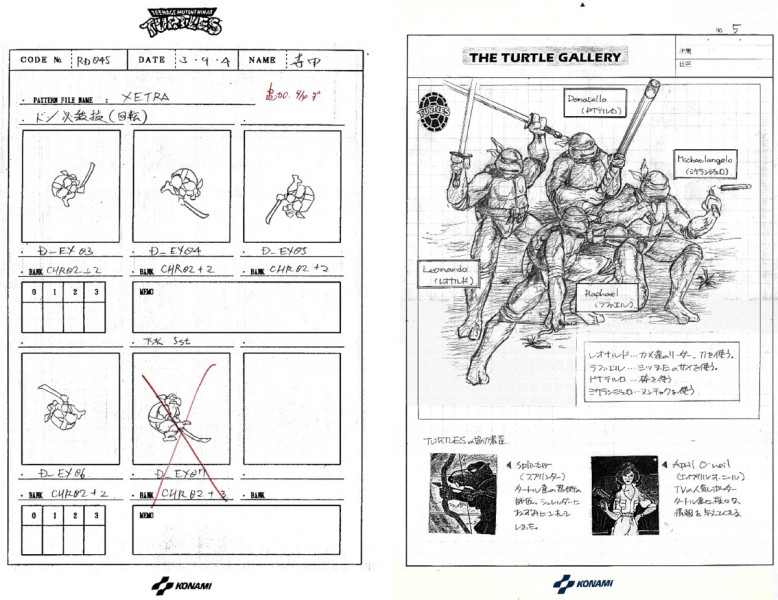
Teenage Mutant Ninja Turtles for the NES (1989) concept art
The Konami Years
The Konami Years
“Konami was one of the first ones that approached us and they seemed sincere and, I’ll say, politely aggressive in that,” Eastman says. “We were a little naïve and very cocky and knew just enough to be dangerous and want to protect our creation. And so, with Konami, we said, ‘This is what we want,’ and they said, ‘Great. Yep. We’ll do that. We’ll work with you. We want you to be involved in it. You’ve created something that has become successful, and we want to know why and treat it right to make sure it translates.’ It was positive from the earliest stages.”
In working with Konami, the duo strived to balance the tone, as the comic was geared towards adults, while the new animated series and toys were created for children. Konami released two titles in 1989, both simply called Teenage Mutant Ninja Turtles. The first one was a single-player action game for the NES developed by subsidiary Ultra Games, where players must conquer various challenges in both side-scrolling and top-down formats – an innovative concept at the time – to save their reporter friend April O’Neil and Master Splinter from the evil Shredder’s clutches.
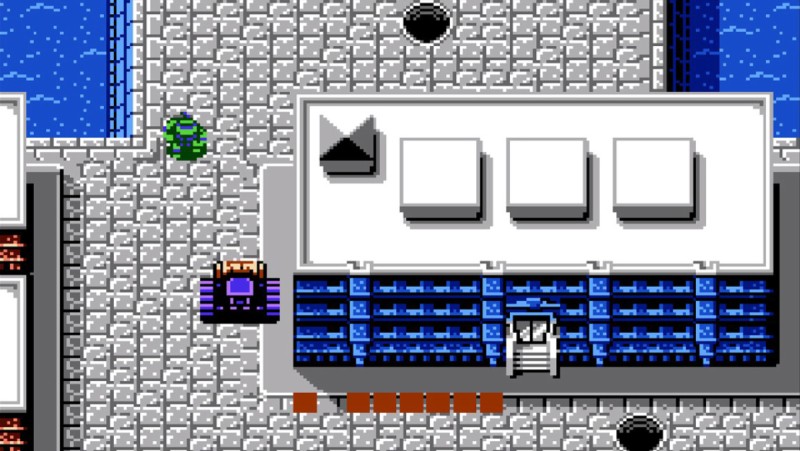
Teenage Mutant Ninja Turtles for the NES (1989)
“The comic book influence of the NES [game] is very strong; the cover itself is from [an alternate cover of] issue number 4, in which they had red bandanas,” Konami producer Charles Murakami, who worked on Teenage Mutant Ninja Turtles: The Cowabunga Collection, says. “You could see the influence of the TV show because there’s Rocksteady and Bebop, and [in the game] the turtles have different colored bandanas. But it’s kind of like this mix between the two but with a very heavy comic book influence, so that kind of explains a lot of why there’s so much strangeness in that game.”
Riding the momentum of the animated series, the NES title was a huge success, selling more than 4 million cartridges by the end of 1990. However, the title was criticized for some extremely difficult segments, the most notorious of which is an underwater level where players must swim through electrified seaweed to disarm bombs before a timer runs out. “When the NES game came out, we would have people approach us at conventions and different appearances that Peter and I would do and be very angry with us because why did we make it so hard to play?” Eastman says with a chuckle. “And Peter and I were like, ‘We can’t even win!’ To this day, I still haven’t gotten through the water level! I tried a lot, but they were really challenging!”

Teenage Mutant Ninja Turtles arcade game (1989)
Thankfully, for people who are like the co-creators and couldn’t get past that early section, that wasn’t the only Ninja Turtles game released by Konami in 1989. Arriving in arcades that fall, the Teenage Mutant Ninja Turtles arcade title fell more in line with what fans of the cartoon expected.
Colorful graphics, big character models, and enhanced audio showcased the gap between console and arcade technology at the time. But it was the gameplay that truly set the ’89 arcade game apart from the rest of what was available. Konami expertly blended the side-scrolling beat ’em up genre with the license to create an experience that captivated imaginations. When you added in the four-player simultaneous co-op functionality and speedy, fluid action, it was a match made in heaven. As a bonus, Eastman could play and make progress in the arcade game thanks to the more linear gameplay – a shared sentiment for many less-gaming-inclined Turtles fans.
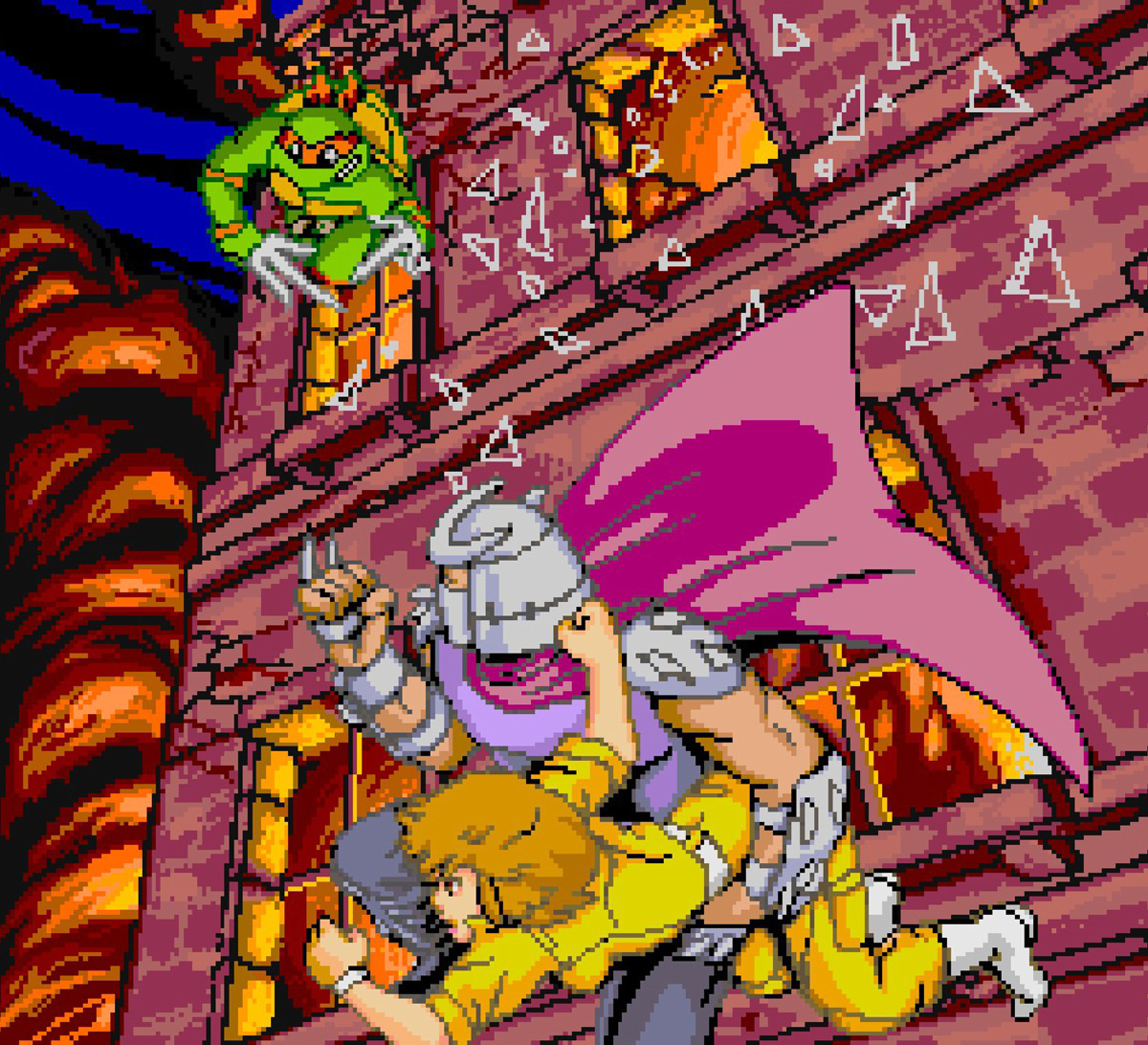
Teenage Mutant Ninja Turtles arcade game (1989)
The title became one of the highest-grossing arcade cabinets of the ’90s and was ported to NES in 1990 under the name Teenage Mutant Ninja Turtles II: The Arcade Game with added content. Not only that, but it inspired a generation of side-scrolling beat ’em up cooperative arcade titles, many of which were also developed by Konami. In 1991, Konami used the format established by TMNT ’89 to release a beloved title based on the popular adult cartoon The Simpsons, but it was the 1992 X-Men arcade game from Konami that caught Eastman’s attention.
“It’s sort of like brain-exploding, humbling, just super cool all at the same time because that was, again, going back to our inspirations of Jack Kirby, I grew up a huge Daredevil fan, Captain America, Batman,” Eastman says. “This full-circle moment of having something as popular as the X-Men and things that were a big influence on us growing up was pretty surreal.”

Teenage Mutant Ninja Turtles II: The Arcade Game for the NES (1990)
The Next Mutation
The Next Mutation
During this era, the Turtles business was booming, and Konami was prolific in capitalizing on it. In addition to its console and arcade titles, the company also released a trilogy of Game Boy games – Fall of the Foot Clan in 1990, Back from the Sewers in 1991, and Radical Rescue in 1993 – as well as several handheld electronic games, a title for DOS, and a third NES title called Teenage Mutant Ninja Turtles III: The Manhattan Project.
Manhattan Project is well-liked and pushed the gameplay established by the original arcade game and its NES port forward. However, it was somewhat overshadowed by another Konami-developed Turtles title released around that same time. Turtles in Time debuted in arcades in 1991 and was released on SNES in 1992, just months after Manhattan Project hit NES.
“The Super NES is out, so a lot of the focus is on the Super Nintendo [game], but Turtles III has its own story, its own unique controls – nothing beats stabbing [enemies] and chucking them off a bridge – it’s one of the most fun games for NES,” Murakami says. “Turtles in Time was in the arcade and it got translated to the Super NES. […] I think that’s why Manhattan Project might have been a little forgotten.”
Turtles in Time’s arcade release was an instant classic due to its flashy graphics, expressive characters, and stellar battles, but for many, the SNES release is the pinnacle of side-scrolling brawlers, even if it was limited by the console only having two controller ports and was not quite able to handle all the animations and 3D elements of the arcade version. To make up for it, the SNES version included several new levels, boss battles, enemy types, and modes.
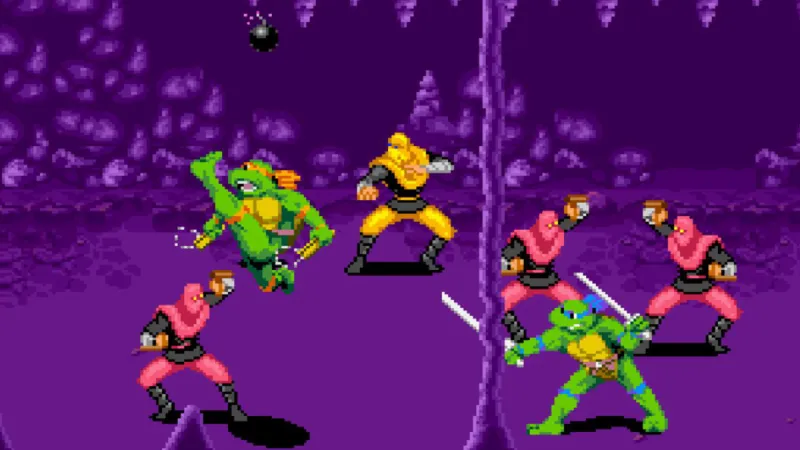
Teenage Mutant Ninja Turtles: Turtles in Time (1991)
Konami had a major hit on its hands, and it wanted to expand its audience even more. The NES couldn’t handle the visual fidelity of Turtles in Time, but the Sega Genesis could. However, there were various parts of the SNES port that utilized the SNES’s Mode 7 scrolling effect. Add the fact that, while the NES and SNES had their own specific TMNT titles, the Genesis did not have an exclusive game, and it made the most sense for Konami to create something based on Turtles in Time, but completely its own.
The resulting title was The Hyperstone Heist, a game based on Turtles in Time but with faster gameplay and fewer stages. However, each stage is longer, with inspiration pulled from both arcade games. Hyperstone Heist wasn’t built from the ground up, but by utilizing the unique strengths of the Genesis console, it carved its own identity while simultaneously adding to the legacy of what many consider to be the greatest TMNT game of all time.
Bringing A Sai To A Street Fight
Bringing a Sai to a Street Fight
Coming off the great heights achieved by the arcade and console games of the late ’80s and early ’90s, Konami began looking for the next evolution of the Turtles. Inspired by the out-of-control popularity of Street Fighter II, Konami leveraged its license of the TMNT brand to capitalize on the fighting game craze. Originally mapped out in design documents as “Teenage Mutant Ninja Turtles V,” the games that would go on to become Tournament Fighters started digging deeper into the Turtles’ character roster with mutants that had only appeared in the Archie Comics series to that point.

Teenage Mutant Ninja Turtles III: The Manhattan Project (1991)
And now that the brand had a following across three major platforms – SNES, Genesis, and NES – Konami wanted to capitalize on the large audience. However, with each console having different capabilities, that meant creating three distinct versions of Tournament Fighters.
The SNES version ended up being the most well-received of the trio thanks to its adherence to the Street Fighter II formula, but the Genesis version also found an audience thanks to its Mortal Kombat inspiration that included being able to break through stages. Much like Manhattan Project before it, the NES version of Tournament Fighters is an oft-forgotten entry thanks to the newer platform versions. But the NES version is, despite its technical limitations, still a solid version of the title and serves as Konami’s final addition to its storied NES library.
Despite each iteration having its own positives and negatives, the Super NES Tournament Fighters stands out as the clear fan favorite and remains a well-liked fighter to this day. However, while the Turtles license was mostly experiencing success to this point, fortunes were about to change for everyone’s favorite Manhattan mutants.
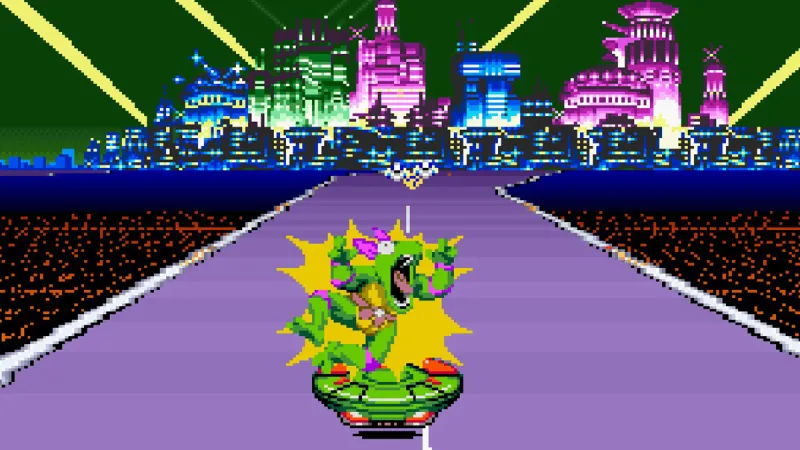
Teenage Mutant Ninja Turtles IV: Turtles in Time (1992)
Back to the Sewers
Back to the Sewers
After the success of Tournament Fighters and the IP’s transposition to an entirely new genre, the TMNT brand felt unstoppable, particularly in the realm of video games. However, the brand began noticing a mainstream decline. In March 1993, Teenage Mutant Ninja Turtles III, the second sequel to the beloved 1990 live-action film, hit theaters to awful reviews and worse fan reception. Meanwhile, 1993 was also when the original animated series underwent massive changes in tone and number of episodes per season.
Additionally, despite the runaway success of the games, 1993 marked the final home console or dedicated handheld video game release for TMNT for 10 years. “It was a period of the Turtles where it had its peak in the early ’90s, and it slowly did this kind of tapering off through ’97, ’98 where, after the original cartoon series was off the air and the live-action series resonated but not enough to warrant beyond two seasons, it was kind of in a bit of a valley,” Eastman says. “[I began thinking] ‘Maybe that’s it. Maybe we’re in the discount bins now, or we’re sort of gone past that.”
In 2000, Eastman sold his stake in the franchise to his longtime partner Peter Laird, and he began working on other projects. During Eastman’s absence, the games sector ramped back up, but with only a fraction of the success of the original titles from more than a decade ago. This time also saw the license jump from Konami to Ubisoft. Unfortunately, most of the games from both publishers received negative reviews; even a 2009 Ubisoft remake of Turtles in Time drew heavy criticism.
Eastman attributes this to the ballooning game budgets and reliance on original IPs created by studios in the mid-to-late ’90s. “It wasn’t, ‘Hey here’s a popular franchise, let’s adapt it into a video game.’ A lot of the video games weren’t based on that, they were based on original concepts like Metal Gear Solid, or you could name a wild number of games that would develop as individual unique properties and grow out the fan base from there,” he says.

Teenage Mutant Ninja Turtles: Tournament Fighters (1993)
The one exception is a Game Boy Advance release based on the 2007 CGI film TMNT. While the PSP and various console versions range from 37 to 63 on review aggregate site Metacritic, the Game Boy Advance version sits at a strong score of 80.
The early games from the Turtles franchise served as a key touchpoint for the development team, particularly the ’89 arcade game and Turtles in Time. “I remember spending all my lunch breaks rushing back from school, going to eat lunch really quickly, and then going across the street to my friend’s house to play Turtles in Time; that’s my fondest memory of video games,” programmer on TMNT for Game Boy Advance Jean-François Major says. “Afterwards, I kind of knew I was going to video games, but I never really thought there would ever be a chance I would work on a Turtles game. To me, that was like a dream.”
Despite his love for the classic multiplayer Turtles gameplay, the limitations of the Game Boy Advance made the team focus on single-player action while still relying on the classic games’ inspiration. It worked, as the chaotic beat ’em up was well-received. Three years later, Major and his team at Ubisoft Montreal were able to realize their vision for multiplayer action in what many consider one of the best modern games in the genre, Scott Pilgrim vs. The World: The Game.

Teenage Mutant Ninja Turtles: Turtles in Time Re-Shelled (2009)
Meanwhile, on the Turtles side, Laird decided it was time for him, too, to move on. In 2009, he sold the franchise to Viacom (now known as Paramount Global), who started the comics back up under IDW Publishing, even bringing Eastman back as a writer and artist. The Turtles found a new television home at the long-running children’s network Nickelodeon and a video game home at Activision.
While the first few games under Paramount didn’t find the kind of success it was hoping for – even the final Activision-published game, 2016’s Mutants in Manhattan, which was developed by renowned studio Platinum Games, fell short of expectations – six years later, fans received a decidedly retro experience featuring a familiar face.
Turtles in (Modern) Time
Turtles in (Modern) Time
Dotemu and Tribute Games, a studio co-founded by Major in 2011, released Shredder’s Revenge, a 2022 game that feels like a true successor to the series’ most beloved games. Featuring the aesthetic of the 1987 animated series (including many of the original voice actors), the 2D beat ’em up gameplay style of the original ’90s games, and up to six-player cooperative play. Shredder’s Revenge harkened back to the golden age of TMNT games, giving Major the chance to finally make the Turtles game of his dreams.
“The sky was the limit; there were no limitations, and we kind of had free rein on going forward with our dream,” Major says. “We didn’t settle on any aspect. We really invested a lot of time just to get the multiplayer aspect right, and just the fact that you can jump in and out at any point really gives it that vibe of the arcade eras.”
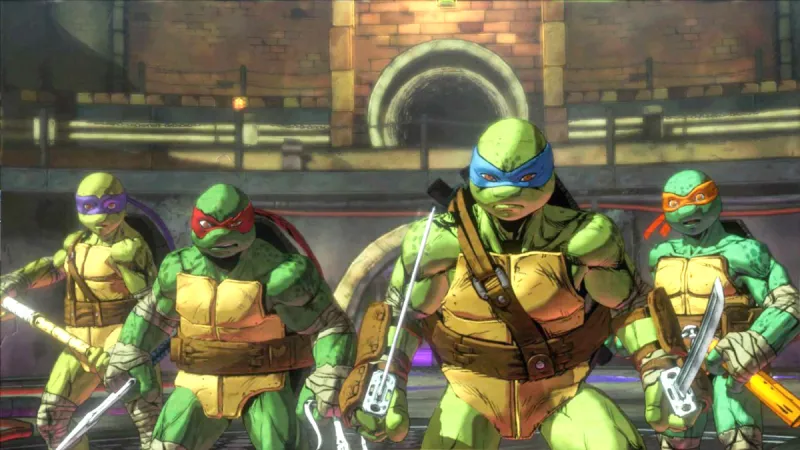
Teenage Mutant Ninja Turtles: Mutants in Manhattan (2016)
Shredder’s Revenge succeeded in being nostalgic and jam-packed with references to the Turtles’ history while also delivering a modern experience. Its approach to bringing something new to the table while also paying homage to the past resonated with fans and critics alike, earning an excellent 87 on Metacritic and holding a “Very Positive” user rating on Steam.
That same year, Digital Eclipse and Konami released The Cowabunga Collection, a title that gathers 13 of the most beloved Turtles games across SNES, Genesis, NES, and Game Boy on modern platforms with added features like online play.
Much like the fan base, Eastman was a fan of both 2022 releases. “Shredder’s Revenge, I thought they put a lot of love into the old-school bit-form structure of the game, but a modern take on that old, classic style,” he says. “It was part of the resurgence where, around that time, I was also working with Konami on The Cowabunga Collection, which was just so brilliantly fantastic. […] I think Shredder’s Revenge and the Cowabunga Collection, everything sort of fell into the right place at the right time for all that to happen with successes in other Turtle areas.”

Teenage Mutant Ninja Turtles: Shredder’s Revenge (2022)
For those wanting something a bit more modern-facing, Paramount plans to play to your interests next. In 2023, a Hades-style Turtles roguelite called Splintered Fate from Super Evil Megacorp released exclusively for Apple Arcade to positive reviews. It was also recently announced that Splintered Fate is coming to Switch this summer, but Paramount isn’t stopping there. “We knew we wanted to start with retro/classic and then as the franchise built, build on it,” Paramount senior vice president of games and emerging media Doug Rosen says. “So much of what I’ve been focused on is really being thoughtful and not just putting out games for the sake of putting out games and licensing the IP, but trying to think of it in terms of a 5-to-10-year plan for the franchise. […] We turn down a lot of opportunities for reasons if they don’t match that. Like, I would say, right now, do we need another retro beat ’em up? I don’t think so right now; we have a great one on the market. So what’s the next genre that does really well?”
This year, players can expect to continue the adventures of the hit 2023 film Teenage Mutant Ninja Turtles: Mutant Mayhem in a follow-up video game from Outright Games called Mutants Unleashed, where a new wave of mutants has flooded New York, disrupting the Turtles’ new happy existence after finding acceptance from society. Like many of the games in TMNT’s history, each Turtle features his own play style, and players can look forward to two-player local co-op.
“That’s one where it does two things: It evolves the gameplay, but it also fits really well with where the film is and other content coming,” Rosen says. “It’s not a movie game, but it’s in that environment. The art style is beautiful, and for anyone who liked the movie, it’s another way in.”

Teenage Mutant Ninja Turtles: The Cowabunga Collection (2022)
But Mutants Unleashed is not the only game on the horizon for the Turtles. Black Forest Games and THQ Nordic are teaming up for a single-player action title based on the dark Turtles comic miniseries The Last Ronin. That storyline, which ran from 2020 to 2022, takes place in an alternate future where New York City has been ravaged by ongoing battles, and the sole surviving member of the Turtles (whose identity is initially unknown) goes on a quest for vengeance.
“[Paramount] was already well down the road with the incredible Mutant Mayhem project, and they said, ‘We’d love to do something with The Last Ronin, but we don’t want to battle each other and take away from [Mutant Mayhem],’” Eastman says. “They said, ‘Let’s go and adapt it as a video game because we can give it all the edge and all the attitude and intensity that you did in the comic series and even go a bit deeper.’ And everything I’ve seen – we’ve been interacting with the development crew – and it looks like some of the sets and some of the characters have literally walked right off the pages of the comic. So beautiful. So fantastic. And so pretty much every fan of Last Ronin that I’ve talked to is really, seriously pumped, like, ‘We get to have an older version of the Turtles just for us as a video game.’”
The Teenage Mutant Ninja Turtles are among the most recognizable characters in the world of pop culture, and their impact on video games cannot be overstated. Though there was a dry period, those days seem long gone, as recent titles like Shredder’s Revenge and The Cowabunga Collection have revitalized much of the love fans of the games from the ’80s and ’90s felt, while games like Mutants Unleashed and The Last Ronin aim to appeal to whole new generations of fans.

Teenage Mutant Ninja Turtles: Mutants Unleashed (2024)
“It’s been such a wonderful journey and adventure that, much like the original comic series and where that started and the evolution of different kinds of technologies and things that we were able to apply to the characters, a big part of the early years of the Turtles was that the video game was so huge and so big,” Eastman says. “Being part of what was, at the time, emerging technology, just was really a fantastic adventure across the board.”
Teenage Mutant Ninja Turtles: Shredder’s Revenge and The Cowabunga Collection are available on all modern platforms. Those looking for a more arcade-style experience can also find the 1989 arcade game and Turtles in Time through Arcade1Up’s cabinets.
With two well-received games and one beloved compilation in the last couple of years, plus two anticipated games on the horizon, the Teenage Mutant Ninja Turtles game franchise is thriving for the first time since the franchise’s ’90s heyday. For longtime fans, it feels so good to meet video game news not with dread, but with a hearty “Cowabunga!”
This article originally appeared in Issue 364 of Game Informer























+ There are no comments
Add yours